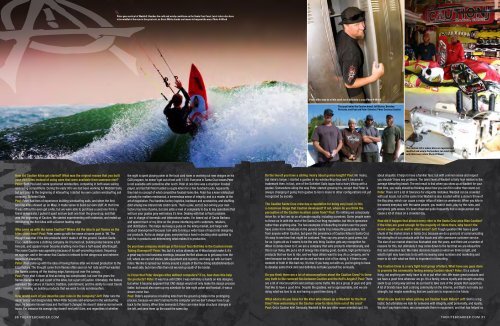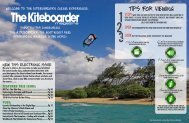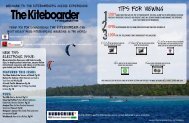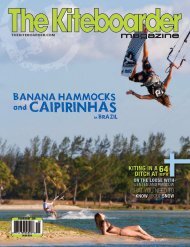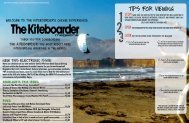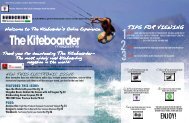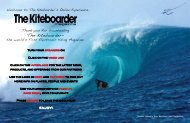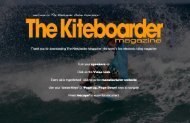June 2009 Issue of The Kiteboarder Magazine
June 2009 Issue of The Kiteboarder Magazine
June 2009 Issue of The Kiteboarder Magazine
- No tags were found...
Create successful ePaper yourself
Turn your PDF publications into a flip-book with our unique Google optimized e-Paper software.
Peter goes vertical at Waddell. Besides the cold and windy conditions on the Santa Cruz Coast, local riders also haveto be mindful <strong>of</strong> the man in the great suit, as Great White sharks are known to frequent the area. Photo H-WoodPoul’s <strong>of</strong>fice may be a little small, but it definitely is cozy. Photo H-Wood<strong>The</strong> guys behind the Caution brand: Jeff Burton, BrendanRichards, and Poul and Peter Schiebel. Photo Courtesy Caution<strong>The</strong> Caution l<strong>of</strong>t is where kites are repaired andmodified and where the founders can catch upwith their team riders. Photo H-WoodHow did Caution kites get started? What was the original reason that you builtyour own kites instead <strong>of</strong> using ones that were available from someone else?Peter: Both Poul and I were sponsored windsurfers, competing in both wave sailingand racing competitions. During the early 90’s we had been working for Waddell Sails,but just prior to the beginning <strong>of</strong> kitesurfing I started my own custom windsurfing sailcompany, Schiebel Sails.Poul: Peter had tons <strong>of</strong> experience building windsurfing sails, and when the firsttwo line kites showed up on Maui, it made sense to build our own stuff. At that timeit was difficult to even get a kite, but we were able to purchase a used one from afriend in Australia. I pulled it apart and we built one from the ground up, and thatwas the beginning <strong>of</strong> Caution. We started experimenting with materials, and ended upintroducing the first kites with a Dacron leading edge.Who came up with the name Caution? Where did the idea to put flames on thekites come from? Poul: Peter came up with the name at some point in ’98. <strong>The</strong>thought was that if the kite products didn’t make it <strong>of</strong>f the ground, Caution SantaCruz could become a clothing company. As it turned out, building kites became a fulltime job, and apparel never became anything more than a half-assed afterthought.<strong>The</strong> name Caution was appealing because <strong>of</strong> its self-promoting nature, frequencyon signage, and in the sense that Caution is relevant to the dangerous and extremeaspects <strong>of</strong> kitesurfing.Peter: Poul came up with the idea <strong>of</strong> having flames after we moved production to theEzzy factory. <strong>The</strong> thought came from flames <strong>of</strong>ten seen on hot rods and Poul wantedthe flames coming <strong>of</strong>f the leading edge, fanning out over the canopy.Poul: Peter shot it down at first as being too complicated, but over the years theflames became not just a part <strong>of</strong> the kites, but a part <strong>of</strong> Caution. Ultimately, the flamesrepresent the culture at Caution: tradition, commitment, and the ability to resist trendswhile focusing on building products that we want to ride as kitersurfers.How would each <strong>of</strong> you describe your roles in the company? Jeff: Peter runs therepair center and designs kites. When Peter became self-employed in the windsurfingdays, he became his own boss and that hasn’t changed. He doesn’t observe normal workhours. For instance his average day doesn’t end until 4 am, and regardless <strong>of</strong> whetherthe night is spent playing poker at the local card room or working out new designs on hisCAD program, he doesn’t get out <strong>of</strong> bed until 11:30. Everyone in Santa Cruz knows Peteris not available until sometime after lunch. Peter at one time was a champion foosballplayer, and last fall Peter hustled a couple kiters for a few hundred bucks. Apparentlythey had no concept <strong>of</strong> what competitive foosball looks like. Peter has a keen intellectualcuriosity for matters mechanical, a tremendous sense <strong>of</strong> integrity, and is a master at theart <strong>of</strong> negotiation. Poul handles factory logistics, hardware and accessories, and shufflingdebt among low interest rate credit cards. That’s a joke, sort <strong>of</strong>, but owning your ownfactory has tons <strong>of</strong> perks, but also adds a level <strong>of</strong> complexity to day to day operations thatwill turn your goatee grey well before it’s time. Dealing with that is Poul’s problem.I am in charge <strong>of</strong> domestic and international sales. I’m based out <strong>of</strong> Santa Barbaraand spend much <strong>of</strong> my time on the phone interfacing with customers, retailers,and distributors. This helps me keep a pulse on the kiting market, and helps withproduct development because I am able to bring a wider base <strong>of</strong> input into designingour products. As far as design goes, everyone has a hand in deciding what qualities tolook for in products and determining what makes it to production.Do you have company meetings at the local Taco Bell like in the Caution movieTaking Davenport? Peter: Yes, but it’s not as dramatic as H-Wood would make it. It’sa great way to hold business meetings, because the Bell allows us to get away from thel<strong>of</strong>t, where we can tell stories, talk equipment and logistics, and keep up with our teamriders. We like to spread our money around a couple <strong>of</strong> the fine dining establishments onthe west side, but more <strong>of</strong>ten than not we end up south <strong>of</strong> the border.Is it true that Peter designs kites without computers? If so, how does this helpthe products? Peter: It was true until 2004. I was definitely a hands on kite designer,but when it became apparent that CAD design would not only make the design processfaster, but would also open up my schedule for late night poker and foosball, it was adream come true.Poul: Peter’s experience in building kites from the ground up helps in the prototypingprocess, because we aren’t married to the computer and we don’t always have to goback to the factory. When time demands it, Peter can make large structural changes inthe l<strong>of</strong>t, and send them up the coast the same day.Do the two <strong>of</strong> you have a sibling rivalry about goatee length? Poul: No rivalry,but mine’s longer. I started a goatee in my windsurfing days and it became atrademark then. In fact, one <strong>of</strong> the Schiebel Sails logos had a hairy Viking with agoatee. Somewhere along the way Peter started growing his, except that Peter isalways changing it going from goatee to lion’s mane to other configurations not yetrecognized by society.<strong>The</strong> Caution Santa Cruz crew has a reputation for being very local. Is thisa conscious image that Caution developed? If not, where do you think theperception <strong>of</strong> the Caution localism came from? Poul: It’s nothing we consciouslystrive for; in fact we rip on all people equally, including ourselves. Some people seemto throw us in with the rest <strong>of</strong> the Santa Cruz thug reputation, but this is ignorancerather than anything else. <strong>The</strong> few examples <strong>of</strong> kitesurfing localism over the yearshave come from individuals in the general Santa Cruz kitesurfing population, notfrom anyone within Caution, but given the prevalence <strong>of</strong> Caution Kites in Santa Cruzit’s easy to see how that might be confused. <strong>The</strong>y say any press is good press, butfor us it gets old as it seems to be the only thing Caution gets any recognition for.When it comes down to it, we are a company that sells products internationally, andthis is our living. We put a lot <strong>of</strong> energy into making great, durable, high performanceproducts that we love to ride, and we hope others want to buy. As a company, we’rehere because we love what we do and we have a lot <strong>of</strong> fun doing it. If there is anyelement <strong>of</strong> truth in this bad rep, it’s that if you hang out with us, you’re going to haveto develop some thick skin and definitely not take yourself too seriously.Do you think there are a lot <strong>of</strong> misconceptions about the Caution Crew? Is thereany truth to the rumored ties between Caution and the Hell’s Angels? Poul: <strong>The</strong>reare a lot <strong>of</strong> misconceptions and perhaps some truths. We are a group <strong>of</strong> guys and girlsthat like to have a good time. Despite the goatees, we’re approachable, and we aredoing what we love to do and having a good time doing it.What advice do you have for the kiter who shows up at Waddell for the firsttime? How welcoming is the Caution crew to riders from out <strong>of</strong> the area?Poul: Get a Caution kite! Seriously, Waddell is like any other wave oriented spot. It’sabout etiquette. It helps to have a familiar face, but with common sense and respectyou shouldn’t have any problems. <strong>The</strong> talent level at Waddell is fairly high relative to theaverage kitesurfing beach. <strong>The</strong> end result is that when you show up at Waddell for yourfirst time, you really should be thinking about how you can fit in rather than stand out.Peter: <strong>The</strong>re isn’t a lot <strong>of</strong> tolerance for etiquette mistakes. Waddell can be crowdedwith just locals, but at the same time Waddell is also located within a stone’s throw <strong>of</strong>the Bay area, which can cause a major influx <strong>of</strong> kiters on weekends. When you kite inthe waves everyday with the same people, you make it work, play by the rules, andeverybody gets waves. It’s been observed quite frequently that a single person cancause a lot <strong>of</strong> chaos on a crowded day.How did it happen that almost every rider in the Santa Cruz area flies Caution?If the kites are good enough for the majority <strong>of</strong> riders there, why hasn’t thebrand caught on as well in other areas? Jeff: Tough question! We have a goodchunk <strong>of</strong> the market share in Santa Cruz because we do a good job <strong>of</strong> communicatingthe strengths <strong>of</strong> our products with the locals and <strong>of</strong>fer awesome customer service.<strong>The</strong> size <strong>of</strong> our market share has fluctuated over the years, and there are a number <strong>of</strong>reasons for this, but ultimately it may come down to the fact that we are kitesurfersfirst and salesmen last. We make decisions based on what we think is right, andwhat’s right may have less to do with increasing sales numbers and marketing andmore to do with what we think is important in kitesurfing.<strong>The</strong> Caution Crew is a very tight-knit group <strong>of</strong> kiters. What have you guys doneto promote the community feeling among Caution riders? Peter: It’s a culturalthing, not anything we really have to do or put effort into. We make great products andwe have a good time wherever we go. It’s a family, where loyalty and straight shootingseem to go a long way and we do our best to take care <strong>of</strong> the people that support us.A lot <strong>of</strong> brands have built a strong community on the internet, and that’s not really ourstrength, but maybe something that we could aim to improve in the future.What do you look for when picking out Caution Team Riders? Jeff: Skill is a bigfactor, but ultimately we look for someone with integrity, solid personality, and loyalty.We don’t pay team riders, we compensate them in equipment, and that has helped us30 thekiteboarder.comthekiteboarder.com 31


